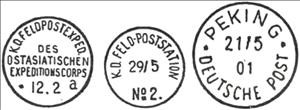Stamp: North and South, by Anton von Werner (1843-1915) (China - German Post Office (General Issues) 1901)
North and South, by Anton von Werner (1843-1915) (China - German Post Office (General Issues) 1901)
01 April (China - German Post Office (General Issues) ) within release Boxer riots in Pechili (Northern China), Field Post goes into circulation Stamp North and South, by Anton von Werner (1843-1915) face value 2 German reichsmark
| Stamp North and South, by Anton von Werner (1843-1915) in catalogues | |
|---|---|
| Michel: | Mi: DR-CHI PVIl |
Stamp is horizontal format.
The two PV issues were used by the field post offices and the imperial post offices in the war zone, they must have postmark dates from 9/1/1900 to 8/31/1901, but there are also later cancellations up to 12/31/1902, which mostly owe their existence to collectors' requests. Cancellations are either one of two types of generic Military Post cancellation or a town cancel dated in period (see back picture). Mi: DR-KIA 15.Also in the issue Boxer riots in Pechili (Northern China), Field Post:
- Stamp - General Post Office, Berlin face value 1;
- Stamp - Germania with imperial crown, inscription 'REICHSPOST' face value 3;
- Stamp - Germania with imperial crown, inscription 'REICHSPOST' face value 5;
- Stamp - Germania with imperial crown, inscription 'REICHSPOST' face value 10;
- Stamp - Germania with imperial crown, inscription 'REICHSPOST' face value 20;
- Stamp - Germania with imperial crown, inscription 'REICHSPOST' face value 25;
- Stamp - Germania with imperial crown, inscription 'REICHSPOST' face value 30;
- Stamp - Germania with imperial crown, inscription 'REICHSPOST' face value 40;
- Stamp - Germania with imperial crown, inscription 'REICHSPOST' face value 50;
- Stamp - Germania with imperial crown, inscription 'REICHSPOST' face value 80;
- Stamp - North and South, by Anton von Werner (1843-1915) face value 2;
- Stamp - SMS Hohenzollern face value 3;
- Stamp - SMS Hohenzollern face value 5;
Stamp North and South, by Anton von Werner (1843-1915) it reflects the thematic directions:
A coat of arms is an heraldic visual design on an escutcheon (i.e. shield), surcoat, or tabard. The coat of arms on an escutcheon forms the central element of the full heraldic achievement which in its whole consists of shield, supporters, crest, and motto. A coat of arms is traditionally unique to an individual person, family (except in the United Kingdom), state, organisation or corporation.
A flag is a piece of fabric (most often rectangular or quadrilateral) with a distinctive design that is used as a symbol, as a signaling device, or as decoration. The term flag is also used to refer to the graphic design employed, and flags have since evolved into a general tool for rudimentary signalling and identification, especially in environments where communication is similarly challenging (such as the maritime environment where semaphore is used). National flags are patriotic symbols with varied wide-ranging interpretations, often including strong military associations due to their original and ongoing military uses. Flags are also used in messaging, advertising, or for other decorative purposes. The study of flags is known as vexillology, from the Latin word vexillum, meaning flag or banner.
Painting is the practice of applying paint, pigment, color or other medium to a solid surface (support base). The medium is commonly applied to the base with a brush, but other implements, such as knives, sponges, and airbrushes, can be used. Painting is a mode of creative expression, and the forms are numerous. Drawing, gesture (as in gestural painting), composition, narration (as in narrative art), or abstraction (as in abstract art), among other aesthetic modes, may serve to manifest the expressive and conceptual intention of the practitioner. Paintings can be naturalistic and representational (as in a still life or landscape painting), photographic, abstract, narrative, symbolistic (as in Symbolist art), emotive (as in Expressionism), or political in nature (as in Artivism). A portion of the history of painting in both Eastern and Western art is dominated by spiritual motifs and ideas. Examples of this kind of painting range from artwork depicting mythological figures on pottery, to Biblical scenes rendered on the interior walls and ceiling of the Sistine Chapel, to scenes from the life of Buddha or other images of Eastern religious origin. In art, the term painting describes both the act and the result of the action. The support for paintings includes such surfaces as walls, paper, canvas, wood, glass, lacquer, clay, leaf, copper and concrete, and the painting may incorporate multiple other materials including sand, clay, paper, plaster, gold leaf, as well as objects. The term painting is also used outside of art as a common trade among craftsmen and builders.



